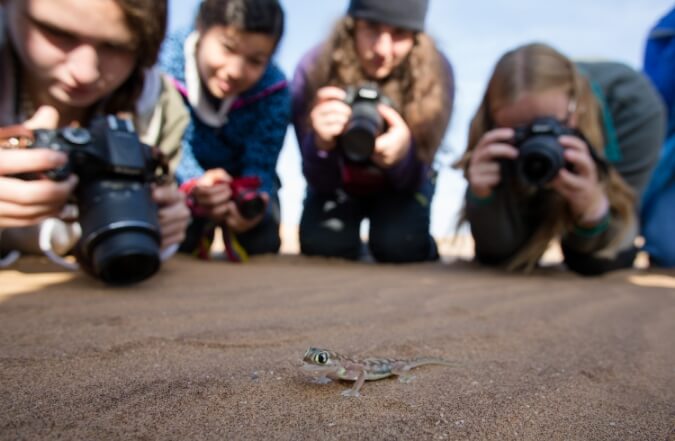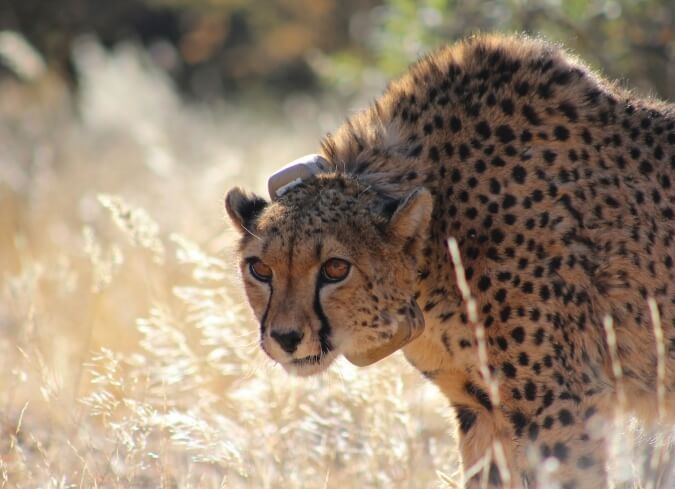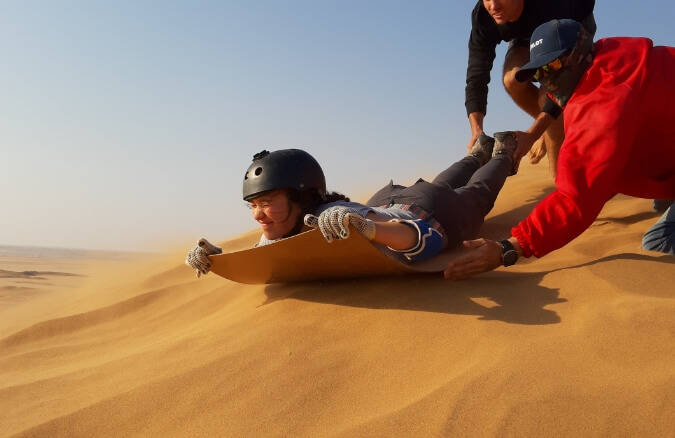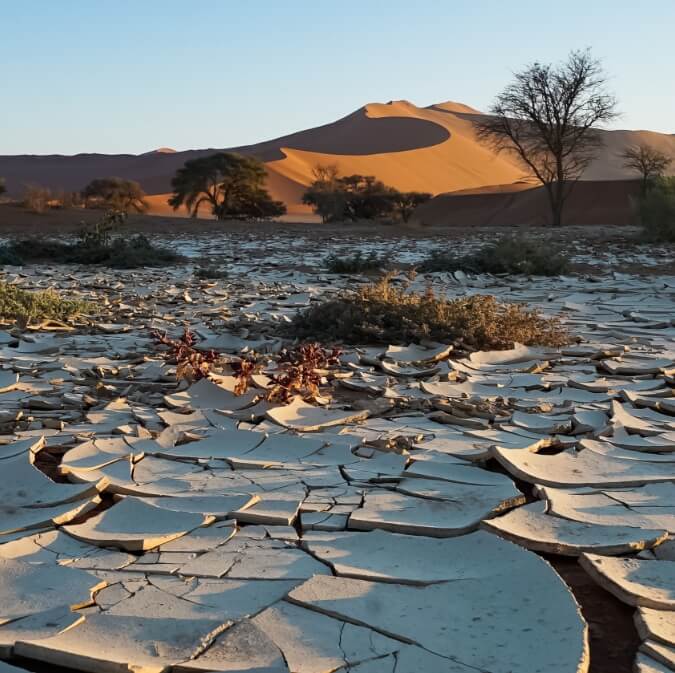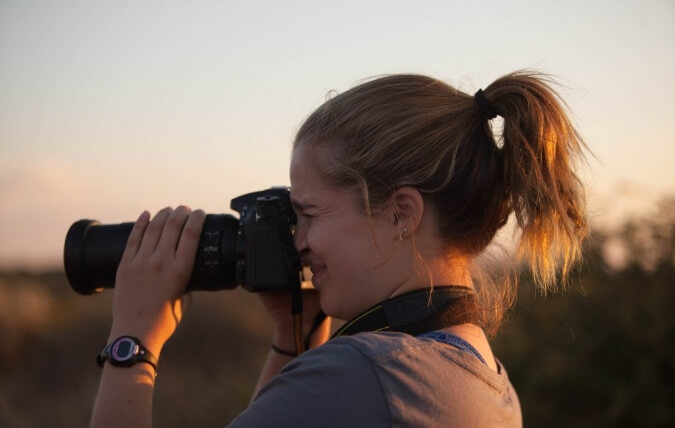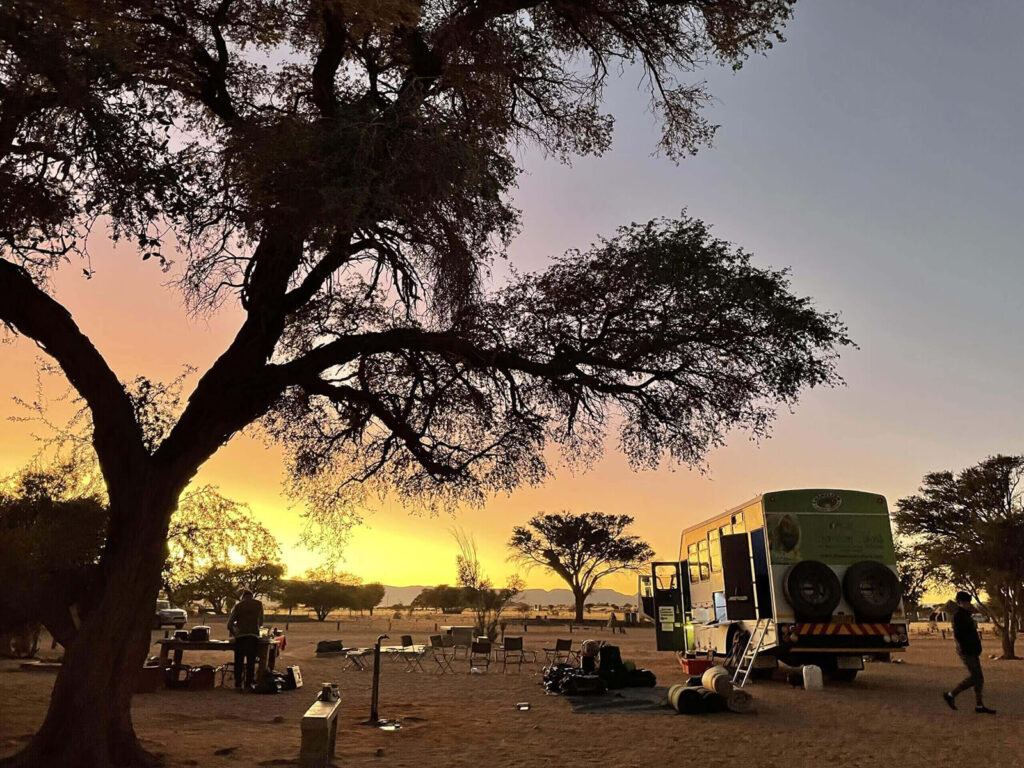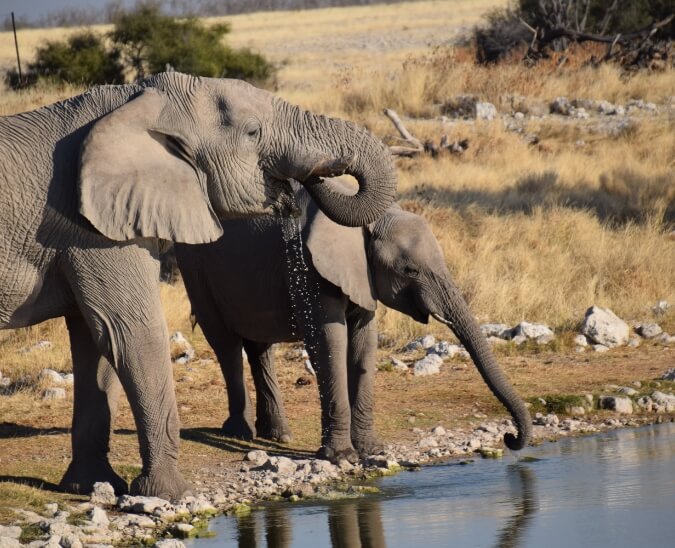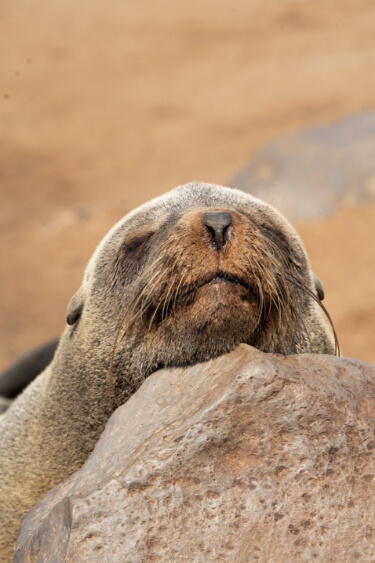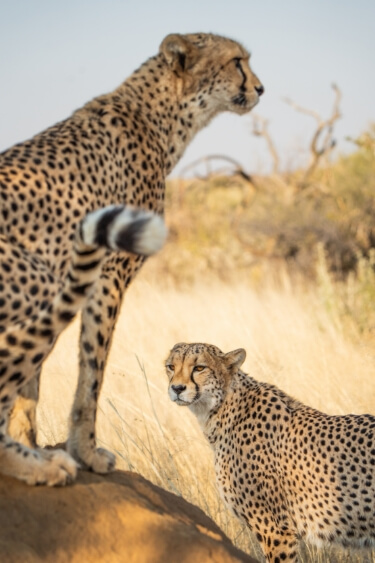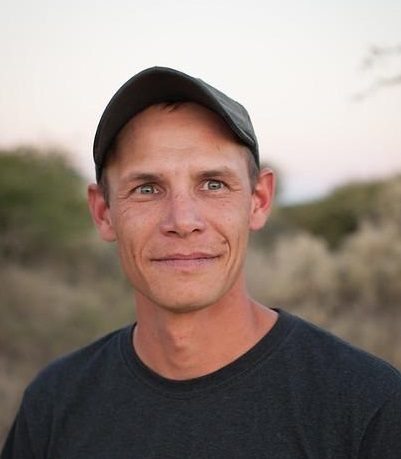Namibia
Desert Safari & Big Cat Conservation
The landscapes of Namibia are home to a wealth of desert-adapted wildlife that conservationists are working hard to protect. This summer, go into the field and experience conservation in action with leading ecologists and other like-minded high school students. Choose either the Photography or Wildlife Conservation track, and delve into your focus area. Along your journey, photograph iconic African wildlife like elephants, hyenas, giraffes, and oryx on safari; go sea kayaking in Walvis Bay; and climb the dunes of the Namib Desert.
- Highlights
• Learn from experts how technology is used to monitor wildlife
• Surf towering desert dunes on a sandboarding excursion
• Go on safari in world-renowned Etosha National Park
Expert
Itinerary
This itinerary represents our best projection of the group’s schedule. However, we may implement changes designed to improve the quality of the program.
Meet your fellow high school student travelers and one or more of your program leaders in New York, and fly together to Windhoek, Namibia. To learn more about how we organize travel, click here.
The program begins at N/a’an ku sê Wildlife Sanctuary, where researchers have developed innovative approaches to protecting predators while reducing predation on local livestock. Settle into your accommodations, get to know your group through an in-depth orientation, then head into the field with local wildlife experts on game counts, collar-tracking exercises, or to set up camera traps at watering holes. Snap close-up shots of resident cheetahs exercising using a lure on a pulley system mimicking wild prey, and zoom out to photograph herds of zebras and springbok in the afternoon sun. Meet with a herpetologist for an introduction to the important role snakes play in the Namibian landscape. Discuss the effects of climate change on this desert ecosystem with field ecologists, and participate in a conservation careers workshop.
Travel south to Sesriem Canyon and Sossusvlei—a salt and clay pan surrounded by towering dunes. Camp overnight in the national park and wake early to photograph the sun rising over the massive orange-red dunes. Pay a visit to the iconic Deadvlei, a stark landscape dotted with ancient, skeletal camel thorn trees. Continue to the seaside city of Swakopmund, and explore the nearby dunes with desert ecologists, learning about the species that have adapted to survive the harsh conditions. Then zoom down dune slopes on a sandboarding excursion. Visit Cape Cross to observe a vast breeding colony of some 100,000 Cape fur seals, and paddle alongside dolphins, flamingos, and pelicans on a guided sea-kayaking adventure in Walvis Bay.
Journey into Damaraland, where the desert harbors unusually succulent plants fed by Atlantic mists. With local guides, hike to the White Lady rock etching, believed to date back at least 2,000 years. Pay a visit to Brandberg Mountain, a giant granite monolith and Namibia’s highest mountain peak; then descend into the neighboring valley and venture across the stark landscapes in search of endangered desert-adapted elephants.
Namibia’s dry season spans April through October, when herds of plains game flock to the waterholes of Etosha National Park, and their predators—lions, leopards, and cheetahs—follow close behind. Enjoy three days on safari here, looking for big cats, giraffes, oryx, rare black-faced impalas, and endemic birds like the bare-cheeked babbler. Stop at watering holes for close-up views of bathing elephants, zebras drinking at the water’s edge, and hartebeests splashing in the shallows. Meet with park rangers and learn about their efforts to encourage conservation through tourism.
Explore the 55,000-acre Okonjima Nature Reserve, home to the AfriCat Foundation, a nonprofit organization dedicated to protecting Namibia’s carnivores and other wildlife in their natural habitat. Join expert trackers in search of elusive leopards, rhinos, hyena, or the endangered pangolin. Talk with AfriCat’s conservation team about predator-conservation outreach efforts, hear about their collaborations with local farmers, and learn about their work to mitigate human-wildlife conflict.
Travel to the Namibian capital of Windhoek. Cap off our journey with visits to artisan markets, museums, presentations of our Workshop projects, and celebrate with a final meal out on the town.
Fly from Windhoek, Namibia, to New York with your group and a leader, then continue on to your final destination. To learn more about how we organize travel, click here.
Itinerary
This itinerary represents our best projection of the group’s schedule. However, we may implement changes designed to improve the quality of the program.
Meet your fellow high school student travelers and one or more of your program leaders in New York, and fly together to Windhoek, Namibia. To learn more about how we organize travel, click here.
The program begins at N/a’an ku sê Wildlife Sanctuary, where researchers have developed innovative approaches to protecting predators while reducing predation on local livestock. Settle into your accommodations, get to know your group through an in-depth orientation, then head into the field with local wildlife experts on game counts, collar-tracking exercises, or to set up camera traps at watering holes. Snap close-up shots of resident cheetahs exercising using a lure on a pulley system mimicking wild prey, and zoom out to photograph herds of zebras and springbok in the afternoon sun. Meet with a herpetologist for an introduction to the important role snakes play in the Namibian landscape. Discuss the effects of climate change on this desert ecosystem with field ecologists, and participate in a conservation careers workshop.
Travel south to Sesriem Canyon and Sossusvlei—a salt and clay pan surrounded by towering dunes. Camp overnight in the national park and wake early to photograph the sun rising over the massive orange-red dunes. Pay a visit to the iconic Deadvlei, a stark landscape dotted with ancient, skeletal camel thorn trees. Continue to the seaside city of Swakopmund, and explore the nearby dunes with desert ecologists, learning about the species that have adapted to survive the harsh conditions. Then zoom down dune slopes on a sandboarding excursion. Visit Cape Cross to observe a vast breeding colony of some 100,000 Cape fur seals, and paddle alongside dolphins, flamingos, and pelicans on a guided sea-kayaking adventure in Walvis Bay.
Journey into Damaraland, where the desert harbors unusually succulent plants fed by Atlantic mists. With local guides, hike to the White Lady rock etching, believed to date back at least 2,000 years. Pay a visit to Brandberg Mountain, a giant granite monolith and Namibia’s highest mountain peak; then descend into the neighboring valley and venture across the stark landscapes in search of endangered desert-adapted elephants.
Namibia’s dry season spans April through October, when herds of plains game flock to the waterholes of Etosha National Park, and their predators—lions, leopards, and cheetahs—follow close behind. Enjoy three days on safari here, looking for big cats, giraffes, oryx, rare black-faced impalas, and endemic birds like the bare-cheeked babbler. Stop at watering holes for close-up views of bathing elephants, zebras drinking at the water’s edge, and hartebeests splashing in the shallows. Meet with park rangers and learn about their efforts to encourage conservation through tourism.
Explore the 55,000-acre Okonjima Nature Reserve, home to the AfriCat Foundation, a nonprofit organization dedicated to protecting Namibia’s carnivores and other wildlife in their natural habitat. Join expert trackers in search of elusive leopards, rhinos, hyena, or the endangered pangolin. Talk with AfriCat’s conservation team about predator-conservation outreach efforts, hear about their collaborations with local farmers, and learn about their work to mitigate human-wildlife conflict.
Travel to the Namibian capital of Windhoek. Cap off our journey with visits to artisan markets, museums, presentations of our Workshop projects, and celebrate with a final meal out on the town.
Fly from Windhoek, Namibia, to New York with your group and a leader, then continue on to your final destination. To learn more about how we organize travel, click here.
Located in southwest Africa, Namibia is known for its vast landscapes, iconic wildlife, and rich cultures. The country is home to more than ten major ethnic groups, including the Ovambo, Kavango, Herero, Damara, and San. The San hunter-gatherers are believed to have inhabited what is now Namibia for more than 2,000 years. Namibia also has many communities with European ancestry. Agriculture and mining are the main economic drivers, along with travel and tourism.
English is the official language of Namibia, and more than two dozen languages and dialects are spoken by Namibian ethnic groups with the most prominent being Oshivambo. Afrikaans is also widely utilized. Our local guides are multilingual.
Namibia is mainly arid desert, and daytime temperatures often rise above 80°F/27°C, then drop below freezing at night. Prepare for the extremes—while the days are hot and dry, it is not unusual to find frost on the ground in the morning while camping.
Namibian food is a diverse mix of African and European cuisines. The typical diet is meat heavy, with beef and chicken as common as oryx or springbok. However, our local outfitters prepare a variety of vegetarian and meat-based meal options and they can accommodate any dietary restrictions as long as we are advised in advance.
Located in southwest Africa, Namibia is known for its vast landscapes, iconic wildlife, and rich cultures. The country is home to more than ten major ethnic groups, including the Ovambo, Kavango, Herero, Damara, and San. The San hunter-gatherers are believed to have inhabited what is now Namibia for more than 2,000 years. Namibia also has many communities with European ancestry. Agriculture and mining are the main economic drivers, along with travel and tourism.
English is the official language of Namibia, and more than two dozen languages and dialects are spoken by Namibian ethnic groups with the most prominent being Oshivambo. Afrikaans is also widely utilized. Our local guides are multilingual.
Namibia is mainly arid desert, and daytime temperatures often rise above 80°F/27°C, then drop below freezing at night. Prepare for the extremes—while the days are hot and dry, it is not unusual to find frost on the ground in the morning while camping.
Namibian food is a diverse mix of African and European cuisines. The typical diet is meat heavy, with beef and chicken as common as oryx or springbok. However, our local outfitters prepare a variety of vegetarian and meat-based meal options and they can accommodate any dietary restrictions as long as we are advised in advance.
What to Expect
Review specific program expectations here. For more general information:
Choose either the Photography or Wildlife Conservation focus, and break into teams to delve further into your area of focus.
Photography
Document your exploration of Namibia in a photography portfolio. Use time-lapse techniques to show the sun dipping behind the dunes at Sossusvlei, zoom in on zebras visiting a watering hole, or photograph a colony of fur seals on the wild Atlantic coast. Practice landscape shots on the desert’s dramatic scenery, and experiment with camera traps to capture images of elusive species.
Wildlife Conservation
Examine Namibia’s unique landscapes and the species that have adapted to these fragile desert ecosystems. Work with researchers at conservation organizations, helping them to protect the country’s big cats, rhinos, and other threatened wildlife. Track leopards with wildlife experts, and discuss the plight of the cheetah with field scientists.
To encourage full engagement and immersion in the Putney travel experience, we limit the use of cell phones and other devices on our High School programs. Students are allowed to use their phones in transit to the program, and keep their devices throughout. During in-country orientation, leaders will lock phones with a code, unlocking them for the second half of the program. During the tech-free portion of the program, students have the opportunity for a weekly call home according to a pre-arranged schedule. For more details, please see our FAQ.
This is a physically active summer travel program and most of each day is spent outdoors. You can expect to participate in field science and conservation work, which involves hiking and data collection in a variety of different landscapes and temperatures (Namibia's arid, desert climate is hot midday and often drops below freezing overnight and into the morning hours). No prior outdoor experience is required, but it is important that you have a desire to be physically active, and that you are interested in outdoor exploration and field work.
At N/a’an ku sê, we stay in large safari tents with beds and ensuite bathrooms. In Swakopmund and in Windhoek, we stay in small hotels. In Sossusvlei, Damaraland, Etosha, and Okonjima, we sleep in camping tents. During this program, students will spend up to 10 nights camping in tents.
At N/a’an ku Sê, we eat meals in a dining hall. In Swakopmund and Windhoek, we eat meals at our hotels and at local restaurants. In Sossusvlei, Damaraland, Etosha, and Okonjima, we prepare meals at our camps with our local safari outfitter.
What to Expect
Review specific program expectations here. For more general information:
Choose either the Photography or Wildlife Conservation focus, and break into teams to delve further into your area of focus.
Photography
Document your exploration of Namibia in a photography portfolio. Use time-lapse techniques to show the sun dipping behind the dunes at Sossusvlei, zoom in on zebras visiting a watering hole, or photograph a colony of fur seals on the wild Atlantic coast. Practice landscape shots on the desert’s dramatic scenery, and experiment with camera traps to capture images of elusive species.
Wildlife Conservation
Examine Namibia’s unique landscapes and the species that have adapted to these fragile desert ecosystems. Work with researchers at conservation organizations, helping them to protect the country’s big cats, rhinos, and other threatened wildlife. Track leopards with wildlife experts, and discuss the plight of the cheetah with field scientists.
To encourage full engagement and immersion in the Putney travel experience, we limit the use of cell phones and other devices on our High School programs. Students are allowed to use their phones in transit to the program, and keep their devices throughout. During in-country orientation, leaders will lock phones with a code, unlocking them for the second half of the program. During the tech-free portion of the program, students have the opportunity for a weekly call home according to a pre-arranged schedule. For more details, please see our FAQ.
This is a physically active summer travel program and most of each day is spent outdoors. You can expect to participate in field science and conservation work, which involves hiking and data collection in a variety of different landscapes and temperatures (Namibia's arid, desert climate is hot midday and often drops below freezing overnight and into the morning hours). No prior outdoor experience is required, but it is important that you have a desire to be physically active, and that you are interested in outdoor exploration and field work.
At N/a’an ku sê, we stay in large safari tents with beds and ensuite bathrooms. In Swakopmund and in Windhoek, we stay in small hotels. In Sossusvlei, Damaraland, Etosha, and Okonjima, we sleep in camping tents. During this program, students will spend up to 10 nights camping in tents.
At N/a’an ku Sê, we eat meals in a dining hall. In Swakopmund and Windhoek, we eat meals at our hotels and at local restaurants. In Sossusvlei, Damaraland, Etosha, and Okonjima, we prepare meals at our camps with our local safari outfitter.
A Day in the Life: N/a’an ku sê
- Morning
- Afternoon
- Evening
A Day in the Life:
N/a’an ku sê
- Morning
- Afternoon
- Evening

Program Directed by
If you have questions or would like to talk further about this program, please get in touch!




